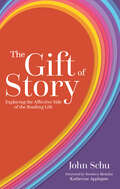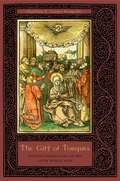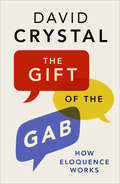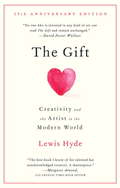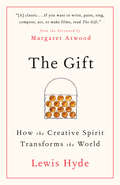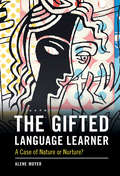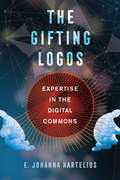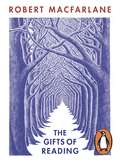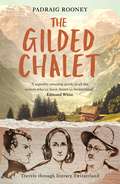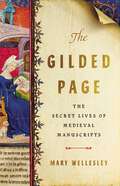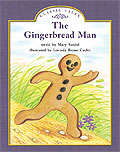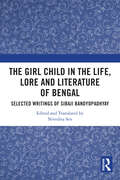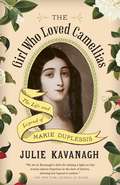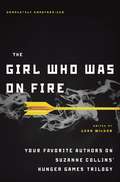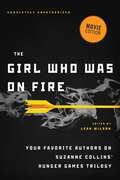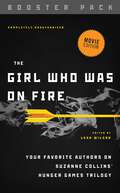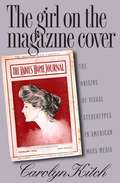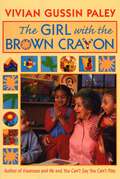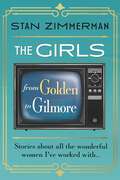- Table View
- List View
The Gift of Story: Exploring the Affective Side of the Reading Life
by John SchuWith the rise of teacher stressors, new and changing state standards, and high-stakes testing, it is more important than ever to remind literacy teachers and teacher-librarians about the reason that brought them to this profession: the love of story.The Gift of Story: Exploring the Affective Side of the Reading Life , by John Schu (affectionately known as Mr. Schu all over reading communities), invites readers to consider literacy beyond its academic benefits and explore how universal truths found in stories can change us, inspire us, connect us to others, answer our deepest questions, and even help us heal along the way. Using his experience as a teacher, librarian, book lover, and story ambassador, Mr. Schu asks readers to reflect on what it means to share their hearts through stories and how it can connect us to individuals and learning communities.The Gift of Story is presented through a study of five affective elements: Healer, Inspiration, Clarifier, Compassion, and Connector.Along the way, readers will encounter insightful contributions from educators, children's writers, and illustrators, as well as recommendations for sharing the gift of story with learning communities including: treasured book suggestions that stir reflection, engaging tips for celebrating literacy, and heart-growing applications to lift classroom and library practices.Celebrate the way we define and imagine ourselvesthrough literacy by using stories to connect to others, build and strengthen community, and honor the children we were called to teach.
The Gift of Tongues: Women's Xenoglossia in the Later Middle Ages
by Christine F. Cooper-RompatoTales of xenoglossia—the instantaneous ability to read, to write, to speak, or to understand a foreign language—have long captivated audiences. Perhaps most popular in Christian religious literature, these stories celebrate the erasing of all linguistic differences and the creation of wider spiritual communities. The accounts of miraculous language acquisition that appeared in the Bible inspired similar accounts in the Middle Ages. Though medieval xenoglossic miracles have their origins in those biblical stories, the medieval narratives have more complex implications. In The Gift of Tongues, Christine Cooper-Rompato examines a wide range of sources to show that claims of miraculous language are much more important to medieval religious culture than previously recognized and are crucial to understanding late medieval English writers such as Geoffrey Chaucer and Margery Kempe.
The Gift of the Gab: How Eloquence Works
by David CrystalWe all know eloquence when we hear it. But what exactly is it? And how might we gain more of it for ourselves? This entertaining and, yes, eloquent book illuminates the power of language from a linguistic point of view and provides fascinating insights into the way we use words. David Crystal, a world-renowned expert on the history and usage of the English language, probes the intricate workings of eloquence. His lively analysis encompasses everyday situations (wedding speeches, business presentations, storytelling) as well as the oratory of great public gatherings. Crystal focuses on the here and now of eloquent speaking--from pitch, pace, and prosody to jokes, appropriateness, and how to wield a microphone. He explains what is going on moment by moment and examines each facet of eloquence. He also investigates topics such as the way current technologies help or hinder our verbal powers, the psychological effects of verbal excellence, and why certain places or peoples are thought to be more eloquent than others. In the core analysis of the book, Crystal offers an extended and close dissection of Barack Obama's electrifying "Yes we can" speech of 2008, in which the president demonstrated full mastery of virtually every element of eloquence--from the simple use of parallelism and an awareness of what not to say, to his brilliant conclusion constructed around two powerful words: dreams and answers.
The Gift: Creativity and the Artist in the Modern World
by Lewis HydeBy now a modern classic,The Gift is a brilliantly orchestrated defense of the value of creativity and of its importance in a culture increasingly governed by money and overrun with commodities. Widely available again after twenty-five years, this book is even more necessary today than when it first appeared. An illuminating and transformative book, and completely original in its view of the world,The Giftis cherished by artists, writers, musicians, and thinkers. It is in itself a gift to all who discover the classic wisdom found in its pages.
The Gift: How the Creative Spirit Transforms the World (Canons Ser.)
by W.Lewis HydeDiscusses the argument that a work of art is essentially a gift and not a commodity.
The Gifted Language Learner: A Case of Nature or Nurture?
by Alene MoyerLanguage learners beyond early childhood are scarcely expected to reach native-like abilities in their new language, yet some do. Are these individuals uniquely gifted? If so, are such gifts innate, or the result of intense drive, optimal experience, opportunity, or something else altogether? Bringing together theory and empirical work from across disciplines, this ground-breaking book aims to better understand the perennial mystery of giftedness in language learning (GLL). Incorporating quantitative, qualitative, and case study data, this analysis demonstrates the need to reach across cognitive, neural, emotional, psychological, and social lines to understand native-likeness in a second language. All such 'outliers' face limits, potentials, and choices. What they do in the face of these is key. With this complexity in mind, specific recommendations are provided to re-orient the research toward an appreciation of the individual's role, and a clearer understanding of the inherent balance of nature and nurture in GLL.
The Gifting Logos: Expertise in the Digital Commons
by E. Johanna HarteliusThe Gifting Logos: Expertise in the Digital Commons provides an extensive analysis of knowledge and creativity in twenty-first century networked culture. Analyzing massive projects like the Wayback Machine, the Internet Archive, and the Creative Commons licenses, The Gifting Logos responds to a fundamental question, What does it mean to know something and to make something? With the idea of a gifting logos, Hartelius integrates three habits of a rhetorical epistemology: the invention of cultural materials such as text, images, and software; the imbuing or encoding of the materials with the creator’s experience; and the constitution and dissemination of the materials as gifts.
The Gifts of Reading
by Robert MacfarlaneFrom the bestselling author of UNDERLAND, THE OLD WAYS and THE LOST WORDS - an essay on the joy of reading, for anyone who has ever loved a bookEvery book is a kind of gift to its reader, and the act of giving books is charged with a special emotional resonance. It is a meeting of three minds (the giver, the author, the recipient), an exchange of intellectual and psychological currency, that leaves each participant enriched. Here Robert Macfarlane recounts the story of a book he was given as a young man, and how he managed eventually to return the favour, though never repay the debt.From one of the most lyrical writers of our time comes a perfectly formed gem, a lyrical celebration of the transcendent power and humanity of the given book.
The Gilded Chalet
by Padraig Rooney'With a sharp eye for detail and a historian's capacious knowledge, Padraig Rooney has written a superbly amusing guide to all the writers who've been drawn to or emerged from Switzerland. This is a book that should be stuffed into every stocking - the perfect Christmas gift!' -Edmund White, author ofThe Flâneur Rainy summer of 1816. Paparazzi train their telescopes across Lake Geneva on the hanky-panky of Byron, Shelley and their womenfolk. Mary Shelley is inspired to writeFrankenstein. Byron diets and dashes offThe Prisoner of Chillon while his doctor, 'Pollydolly', gives birth toThe Vampyre. Percy Shelley almost drowns in the lake. Together they put Switzerland on the literary map. From Caesar, Rousseau and the Romantics, from Conan Doyle to le Carré, Hesse and Highsmith writers have scratched their names on the Swiss chalet. In the nineteenth century they came for fresh air, fresh milk and the sublime scenery, escaping tuberculosis and smog. Switzerland became spa central, a place of health fads, luxury hotels and nude sunbathing. Sherlock Holmes fell to his death only to be resurrected. H. G. Wells thought he'd died and gone to heaven. Hermann Hesse had himselfburied to the neck as a cure for alcoholism. Thomas Mann wroteThe Magic Mountain and lusted after the sailor suits. Neutral Switzerland became a haven in the twentieth century for Borges, Joyce, Remarque, Hemingway, Fitzgerald, Nabokov and Highsmith. They wrote their classic works up some secluded valley, in a coldwater flat in Zürich or in a five-star hotel. The Gilded Chalet took them in and gave them a suite with a view. Anarchists, spies and detectives came too. Sherlock Holmes, Maugham's Ashenden, Fleming's Bond, le Carré's spooks and double agents. Glauser and Dürrenmatt invented Swiss noir - not a chocolate but a style. Behind the squeaky-clean facade, Swiss and foreign writers often found something rotten in the state. Laundered art and money, the world's slush funds, daylight robbery. Switzerland's travel writers Maillart, Eberhardt, Schwarzenbach and Bouvier couldn't wait to make their escape to a bigger air and a warmer climate. The Gilded Chalet is crammed with old lederhosen and new butterflies, spas and spies, fool's gold and numbered accounts. Part detective work, part treasure chest, full of history and scandal, award-winning writer Padraig Rooney takes you on a grand tour of two centuries of great writing by both Swiss and foreign authors and shows how Switzerland has always been at the center of literary Europe.
The Gilded Chalet: Off-Piste in Literary Switzerland
by Padraig Rooney'With a sharp eye for detail and a historian's capacious knowledge, Padraig Rooney has written a superbly amusing guide to all the writers who've been drawn to or emerged from Switzerland. This is a book that should be stuffed into every stocking - the perfect Christmas gift!' -Edmund White, author of The FlâneurRainy summer of 1816. Paparazzi train their telescopes across Lake Geneva on the hanky-panky of Byron, Shelley and their womenfolk. Mary Shelley is inspired to write Frankenstein. Byron diets and dashes off The Prisoner of Chillon while his doctor, 'Pollydolly', gives birth to The Vampyre. Percy Shelley almost drowns in the lake. Together they put Switzerland on the literary map.From Caesar, Rousseau and the Romantics, from Conan Doyle to le Carré, Hesse and Highsmith writers have scratched their names on the Swiss chalet. In the nineteenth century they came for fresh air, fresh milk and the sublime scenery, escaping tuberculosis and smog. Switzerland became spa central, a place of health fads, luxury hotels and nude sunbathing. Sherlock Holmes fell to his death only to be resurrected. H. G. Wells thought he'd died and gone to heaven. Hermann Hesse had himself buried to the neck as a cure for alcoholism. Thomas Mann wrote The Magic Mountain and lusted after the sailor suits.Neutral Switzerland became a haven in the twentieth century for Borges, Joyce, Remarque, Hemingway, Fitzgerald, Nabokov and Highsmith. They wrote their classic works up some secluded valley, in a coldwater flat in Zürich or in a five-star hotel. The Gilded Chalet took them in and gave them a suite with a view.Anarchists, spies and detectives came too. Sherlock Holmes, Maugham's Ashenden, Fleming's Bond, le Carré's spooks and double agents. Glauser and Dürrenmatt invented Swiss noir - not a chocolate but a style. Behind the squeaky-clean facade, Swiss and foreign writers often found something rotten in the state. Laundered art and money, the world's slush funds, daylight robbery.Switzerland's travel writers Maillart, Eberhardt, Schwarzenbach and Bouvier couldn't wait to make their escape to a bigger air and a warmer climate. The Gilded Chalet is crammed with old lederhosen and new butterflies, spas and spies, fool's gold and numbered accounts.Part detective work, part treasure chest, full of history and scandal, award-winning writer Padraig Rooney takes you on a grand tour of two centuries of great writing by both Swiss and foreign authors and shows how Switzerland has always been at the center of literary Europe.
The Gilded Chalet: Off-Piste in Literary Switzerland
by Padraig Rooney'With a sharp eye for detail and a historian's capacious knowledge, Padraig Rooney has written a superbly amusing guide to all the writers who've been drawn to or emerged from Switzerland. This is a book that should be stuffed into every stocking - the perfect Christmas gift!' -Edmund White, author of The FlâneurRainy summer of 1816. Paparazzi train their telescopes across Lake Geneva on the hanky-panky of Byron, Shelley and their womenfolk. Mary Shelley is inspired to write Frankenstein. Byron diets and dashes off The Prisoner of Chillon while his doctor, 'Pollydolly', gives birth to The Vampyre. Percy Shelley almost drowns in the lake. Together they put Switzerland on the literary map.From Caesar, Rousseau and the Romantics, from Conan Doyle to le Carré, Hesse and Highsmith writers have scratched their names on the Swiss chalet. In the nineteenth century they came for fresh air, fresh milk and the sublime scenery, escaping tuberculosis and smog. Switzerland became spa central, a place of health fads, luxury hotels and nude sunbathing. Sherlock Holmes fell to his death only to be resurrected. H. G. Wells thought he'd died and gone to heaven. Hermann Hesse had himself buried to the neck as a cure for alcoholism. Thomas Mann wrote The Magic Mountain and lusted after the sailor suits.Neutral Switzerland became a haven in the twentieth century for Borges, Joyce, Remarque, Hemingway, Fitzgerald, Nabokov and Highsmith. They wrote their classic works up some secluded valley, in a coldwater flat in Zürich or in a five-star hotel. The Gilded Chalet took them in and gave them a suite with a view.Anarchists, spies and detectives came too. Sherlock Holmes, Maugham's Ashenden, Fleming's Bond, le Carré's spooks and double agents. Glauser and Dürrenmatt invented Swiss noir - not a chocolate but a style. Behind the squeaky-clean facade, Swiss and foreign writers often found something rotten in the state. Laundered art and money, the world's slush funds, daylight robbery.Switzerland's travel writers Maillart, Eberhardt, Schwarzenbach and Bouvier couldn't wait to make their escape to a bigger air and a warmer climate. The Gilded Chalet is crammed with old lederhosen and new butterflies, spas and spies, fool's gold and numbered accounts.Part detective work, part treasure chest, full of history and scandal, award-winning writer Padraig Rooney takes you on a grand tour of two centuries of great writing by both Swiss and foreign authors and shows how Switzerland has always been at the center of literary Europe.
The Gilded Chalet: Off-Piste in Literary Switzerland
by Padraig Rooney'With a sharp eye for detail and a historian's capacious knowledge, Padraig Rooney has written a superbly amusing guide to all the writers who've been drawn to or emerged from Switzerland. This is a book that should be stuffed into every stocking - the perfect Christmas gift!' -Edmund White, author of The FlâneurRainy summer of 1816. Paparazzi train their telescopes across Lake Geneva on the hanky-panky of Byron, Shelley and their womenfolk. Mary Shelley is inspired to write Frankenstein. Byron diets and dashes off The Prisoner of Chillon while his doctor, 'Pollydolly', gives birth to The Vampyre. Percy Shelley almost drowns in the lake. Together they put Switzerland on the literary map.From Caesar, Rousseau and the Romantics, from Conan Doyle to le Carré, Hesse and Highsmith writers have scratched their names on the Swiss chalet. In the nineteenth century they came for fresh air, fresh milk and the sublime scenery, escaping tuberculosis and smog. Switzerland became spa central, a place of health fads, luxury hotels and nude sunbathing. Sherlock Holmes fell to his death only to be resurrected. H. G. Wells thought he'd died and gone to heaven. Hermann Hesse had himself buried to the neck as a cure for alcoholism. Thomas Mann wrote The Magic Mountain and lusted after the sailor suits.Neutral Switzerland became a haven in the twentieth century for Borges, Joyce, Remarque, Hemingway, Fitzgerald, Nabokov and Highsmith. They wrote their classic works up some secluded valley, in a coldwater flat in Zürich or in a five-star hotel. The Gilded Chalet took them in and gave them a suite with a view.Anarchists, spies and detectives came too. Sherlock Holmes, Maugham's Ashenden, Fleming's Bond, le Carré's spooks and double agents. Glauser and Dürrenmatt invented Swiss noir - not a chocolate but a style. Behind the squeaky-clean facade, Swiss and foreign writers often found something rotten in the state. Laundered art and money, the world's slush funds, daylight robbery.Switzerland's travel writers Maillart, Eberhardt, Schwarzenbach and Bouvier couldn't wait to make their escape to a bigger air and a warmer climate. The Gilded Chalet is crammed with old lederhosen and new butterflies, spas and spies, fool's gold and numbered accounts.Part detective work, part treasure chest, full of history and scandal, award-winning writer Padraig Rooney takes you on a grand tour of two centuries of great writing by both Swiss and foreign authors and shows how Switzerland has always been at the center of literary Europe.
The Gilded Chalet: Off-Piste in Literary Switzerland
by Padraig Rooney'With a sharp eye for detail and a historian's capacious knowledge, Padraig Rooney has written a superbly amusing guide to all the writers who've been drawn to or emerged from Switzerland. This is a book that should be stuffed into every stocking - the perfect Christmas gift!' -Edmund White, author of The FlâneurRainy summer of 1816. Paparazzi train their telescopes across Lake Geneva on the hanky-panky of Byron, Shelley and their womenfolk. Mary Shelley is inspired to write Frankenstein. Byron diets and dashes off The Prisoner of Chillon while his doctor, 'Pollydolly', gives birth to The Vampyre. Percy Shelley almost drowns in the lake. Together they put Switzerland on the literary map.From Caesar, Rousseau and the Romantics, from Conan Doyle to le Carré, Hesse and Highsmith writers have scratched their names on the Swiss chalet. In the nineteenth century they came for fresh air, fresh milk and the sublime scenery, escaping tuberculosis and smog. Switzerland became spa central, a place of health fads, luxury hotels and nude sunbathing. Sherlock Holmes fell to his death only to be resurrected. H. G. Wells thought he'd died and gone to heaven. Hermann Hesse had himself buried to the neck as a cure for alcoholism. Thomas Mann wrote The Magic Mountain and lusted after the sailor suits.Neutral Switzerland became a haven in the twentieth century for Borges, Joyce, Remarque, Hemingway, Fitzgerald, Nabokov and Highsmith. They wrote their classic works up some secluded valley, in a coldwater flat in Zürich or in a five-star hotel. The Gilded Chalet took them in and gave them a suite with a view.Anarchists, spies and detectives came too. Sherlock Holmes, Maugham's Ashenden, Fleming's Bond, le Carré's spooks and double agents. Glauser and Dürrenmatt invented Swiss noir - not a chocolate but a style. Behind the squeaky-clean facade, Swiss and foreign writers often found something rotten in the state. Laundered art and money, the world's slush funds, daylight robbery.Switzerland's travel writers Maillart, Eberhardt, Schwarzenbach and Bouvier couldn't wait to make their escape to a bigger air and a warmer climate. The Gilded Chalet is crammed with old lederhosen and new butterflies, spas and spies, fool's gold and numbered accounts.Part detective work, part treasure chest, full of history and scandal, award-winning writer Padraig Rooney takes you on a grand tour of two centuries of great writing by both Swiss and foreign authors and shows how Switzerland has always been at the center of literary Europe.
The Gilded Chalet: Off-piste in Literary Switzerland
by Padraig RooneyIn the summer of 1816 paparazzi trained their telescopes on Byron and the Shelleys across Lake Geneva. Mary Shelley babysat and wrote Frankenstein. Byron dieted and penned The Prisoner of Chillon. His doctor, Polidori, was dreaming up The Vampyre. Together they put Switzerland on the map.From Rousseau to Nabokov, le Carré to Conan Doyle, Hemingway to Hesse to Highsmith, Switzerland has always provided a refuge for writers as an escape from world wars, oppression, tuberculosis... or marriage. For Swiss writers from the country was like a gilded prison. The Romantics, the utopians and other spiritual seekers viewed Switzerland as a land of milk and honey, as nature's paradise. In the twentieth century, spying in neutral Switzerland spawned the finest espionage and crime fiction.Part detective work, part treasure chest, The Gilded Chalet takes you on a grand tour of the birthplace of our best-loved stories, revealing how Switzerland became the landscape of our imagination.
The Gilded Page: The Secret Lives of Medieval Manuscripts
by Mary WellesleyA breathtaking journey into the hidden history of medieval manuscripts, from the Lindisfarne Gospels to the ornate Psalter of Henry VIII&“A delight—immersive, conversational, and intensely visual, full of gorgeous illustrations and shimmering description.&” –Helen Castor, author of She-WolvesMedieval manuscripts can tell us much about power and art, knowledge and beauty. Many have survived because of an author&’s status—part of the reason we have so much of Chaucer&’s writing, for example, is because he was a London-based government official first and a poet second. Other works by the less influential have narrowly avoided ruin, like the book of illiterate Margery Kempe, found in a country house closet, the cover nibbled on by mice. Scholar Mary Wellesley recounts the amazing origins of these remarkable manuscripts, surfacing the important roles played by women and ordinary people—the grinders, binders, and scribes—in their creation and survival.The Gilded Page is the story of the written word in the manuscript age. Rich and surprising, it shows how the most exquisite objects ever made by human hands came from unexpected places.&“Mary Wellesley is a born storyteller and The Gilded Page is as good as historical writing gets. This is a sensational debut by a wonderfully gifted historian.&” —Dan Jones, bestselling author of The Plantagenets and The Templars
The Gingerbread Man (Fountas & Pinnell LLI Green #Level H, Lesson 83)
by Mary SandelFountas and Pinnell Leveled Literacy Intervention Green System -- 1st Grade
The Girl Child in the Life, Lore and Literature of Bengal: Selected Writings of Sibaji Bandyopadhyay
by Nivedita SenContemporary children’s literature in Bangla celebrates irreverent, defiant and deviant boys whose subversive doings critique the parenting and schooling they go through, while the girl child is neglected and marginalised. The rare fictional girls who show resilience and demand a normal childhood are consciously silenced, or contained and assimilated within unwritten masculinist norms. This book –a compilation of translated works of the author, critic and academic, Sibaji Bandyopadhyay –focuses on gender and childhood in Bengal.The book includes a translation of his Bangla Shishusahityer Chhoto Meyera (Little Girls in Bangla Children’s Literature), as well as a translated essay on Thakurma’ Jhuli (Grandma’s Sack), a collection of Bangla folk tales and fairytales from early twentieth century that underscores the subaltern role of adolescent female characters with hardly any agency or voice in the oral legends and folklore of Bengal. The translation of the piece ‘An Incredible Transition’ from Bandyopadhyay’s Abar Shishushiksha (On Children’s Education Again) applauds the role of Indian social reformers and British educationists in initiating women’s education in Bengal, while questioning the erasure of protagonists who are girls in the nineteenth-century primers.Interrogating gendered constructions in diverse genres of literature while revisiting the subject of female education, this book will be of interest to students of children’s literature, comparative literature, popular literature, gender studies, translation studies, culture studies and South Asian writings.
The Girl Who Loved Camellias: The Life and Legend of Marie Duplessis
by Julie KavanaghFrom the author of Nureyev, the definitive biography of the celebrated Russian dancer, now comes the astonishing and unknown story of Marie Duplessis, the courtesan who inspired Alexandre Dumas fils's novel and play La dame aux camélias, Giuseppe Verdi's opera La Traviata, George Cukor's film Camille, and Frederick Ashton's ballet Marguerite and Armand. Sarah Bernhardt, Eleonora Duse, Greta Garbo, Isabelle Huppert, Maria Callas, Anna Netrebko, and Margot Fonteyn are just a few of the celebrated actors, singers, and dancers who have portrayed her. Drawing on new research, Julie Kavanagh brilliantly re-creates the short, intense, and passionate life of the tall, pale, slender girl who at thirteen fled her brute of a father and Normandy to go to Paris, where she would become one of the grand courtesans of the 1840s. France's national treasure, Alexandre Dumas père, was intrigued by her, his son became her lover, and Franz Liszt, too, fell under her spell. Quick to adapt an aristocratic mien, with elegant clothes, a coach, and a grand apartment, she entertained a salon of dandies, writers, and artists. Fascinating to both men and women, Marie, with her stylish outfits and signature camellias, was always a subject of great interest at the opera or at the Café de Paris, where she sat at the table of the director of the Paris Opéra, along with the director of the Théâtre Variétés, the infamous dancer Lola Montez, and others. Her early death at age twenty-three from tuberculosis created an outpouring of sympathy, noted by Charles Dickens, who wrote in February 1847: "For several days all questions political, artistic, commercial have been abandoned by the papers. Everything is erased in the face of an incident which is far more important, the romantic death of one of the glories of the demi-monde, the beautiful, the famous Marie Duplessis." With The Girl Who Loved Camellias, Kavanagh has written a compelling and poignant life of a nineteenth-century muse whose independent and modern spirit has timeless appeal.
The Girl Who Was on Fire
by Ned Vizzini Adrienne Kress Sarah Darer Littman Carrie Ryan Bree Despain Jennifer Lynn Barnes Cara Lockwood Sarah Rees Brennan Lili Wilkinson Leah Wilson Mary Borsellino Terri Clark Blythe Woolston Elizabeth M. ReesKatniss Everdeen's adventures may have come to an end, but her story continues to blaze in the hearts of millions worldwide.In The Girl Who Was on Fire, thirteen YA authors take you back to Panem with moving, dark, and funny pieces on Katniss, the Games, Gale and Peeta, reality TV, survival, and more. From the trilogy's darker themes of violence and social control to fashion and weaponry, the collection's exploration of the Hunger Games reveals exactly how rich, and how perilous, protagonist Katniss' world really is. How does the way the Games affect the brain explain Haymitch's drinking, Annie's distraction, and Wiress' speech problems? What does the rebellion have in common with the War on Terror? Why isn't the answer to "Peeta or Gale?" as interesting as the question itself? What should Panem have learned from the fates of other hedonistic societies throughout history-and what can we?The Girl Who Was on Fire covers all three books in the Hunger Games trilogy.CONTRIBUTORS: .Jennifer Lynn Barnes, Mary Borsellino, Sarah Rees Brennan, Terri Clark, Bree Despain, Adrienne Kress, Cara Lockwood, Elizabeth M. Rees, Carrie Ryan, Ned Vizzini, Lili Wilkinson, Blythe Woolston, Sarah Darer Littman
The Girl Who Was on Fire (Movie Edition): Your Favorite Authors on Suzanne Collins' Hunger Games Trilogy
by Brent Hartinger Diana PeterfreundIncludes 3 brand new essays on Gale, the Games, and Mockingjay! **Already read the first edition of The Girl Who Was on Fire? Look for The Girl Who Was on Fire - Booster Pack to get just the three new essays and the extra movie content.** Katniss Everdeen's adventures may have come to an end, but her story continues to blaze in the hearts of millions worldwide. In The Girl Who Was on Fire - Movie Edition, sixteen YA authors take you back to the world of the Hunger Games with moving, dark, and funny pieces on Katniss, the Games, Gale and Peeta, reality TV, survival, and more. From the trilogy's darker themes of violence and social control to fashion and weaponry, the collection's exploration of the Hunger Games reveals exactly how rich, and how perilous, Panem, and the series, really is. How does the way the Games affect the brain explain Haymitch's drinking, Annie's distraction, and Wiress' speech problems? What does the rebellion have in common with the War on Terror? Why isn't the answer to &“Peeta or Gale?" as interesting as the question itself? What should Panem have learned from the fates of other hedonistic societies throughout history—and what can we? CONTRIBUTORS: Jennifer Lynn Barnes, Mary Borsellino, Sarah Rees Brennan, Terri Clark, Bree Despain, Adrienne Kress, Sarah Darer Littman, Cara Lockwood, Elizabeth M. Rees, Carrie Ryan, Ned Vizzini, Lili Wilkinson, Blythe Woolston, Diana Peterfreund (NEW), Brent Hartinger (NEW), Jackson Pearce (NEW)
The Girl Who Was on Fire - Booster Pack: Your Favorite Authors on Suzanne Collins' Hunger Games Trilogy
by Brent Hartinger Diana PeterfreundThis e-book only Booster Pack is designed for readers who have read the first edition of The Girl Who Was on Fire. The Booster Pack includes ONLY the three brand new essays included in The Girl Who Was on Fire - Movie Edition, plus access to 10,000 words of extra, e-book only content: the contributors' thoughts on the Hunger Games film. The first edition of The Girl Who Was on Fire offered even more to think about for readers already engrossed by the world of the Hunger Games. From the trilogy's darker themes of violence and social control to reality television, fashion and weaponry, the collection's exploration of the Hunger Games by other YA writers revealed exactly how rich, and how perilous, protagonist Katniss' world really is. These three new essays discuss game theory in the Hunger Games, mixed opinions about Mockingjay, and why we shouldn't forget about Gale, just because Katniss chose Peeta. This e-book also gives you access to special content from our writers right after the release of The Hunger Games on the big screen: their thoughts on the film.
The Girl on the Magazine Cover: The Origins of Visual Stereotypes in American Mass Media
by Carolyn KitchFrom the Gibson Girl to the flapper, from the vamp to the New Woman, Carolyn Kitch traces mass media images of women to their historical roots on magazine covers, unveiling the origins of gender stereotypes in early-twentieth-century American culture.Kitch examines the years from 1895 to 1930 as a time when the first wave of feminism intersected with the rise of new technologies and media for the reproduction and dissemination of visual images. Access to suffrage, higher education, the professions, and contraception broadened women's opportunities, but the images found on magazine covers emphasized the role of women as consumers: suffrage was reduced to spending, sexuality to sexiness, and a collective women's movement to individual choices of personal style. In the 1920s, Kitch argues, the political prominence of the New Woman dissipated, but her visual image pervaded print media. With seventy-five photographs of cover art by the era's most popular illustrators, The Girl on the Magazine Cover shows how these images created a visual vocabulary for understanding femininity and masculinity, as well as class status. Through this iconic process, magazines helped set cultural norms for women, for men, and for what it meant to be an American, Kitch contends.
The Girl with the Brown Crayon
by Vivian G. PaleyOnce again Vivian Paley takes us into the inquiring minds and the dramatic worlds of young children learning in the kindergarten classroom.
The Girl's Like Spaghetti: Why, You Can't Manage Without Apostrophes!
by Lynne Truss Bonnie TimmonsA giant kids' playground certainly sounds like fun, but you might want to watch out in the giant kid's playground; he has a tendency to step on people. A sign stating, "we're here to help", would definitely disappoint the customers if the apostrophe were removed. Lynne Truss and Bonnie Timmons once again illustrate the hilarious confusion that punctuation can cause.
The Girls: From Golden to Gilmore
by Stan Zimmerman&“...the very definition of a page-turner. READ THIS BOOK!&” – Colin Mochrie, &“Whose Line is It Anyway?,&” &“Hyprov&” Featured on Watch What Happens Live! With Andy Cohen, People Magazine, Queerty Magazine, Fox Digital News, The New York Post, The Daily Mail, The Hollywood Reporter, and Out Magazine.The Girls: From Golden to Gilmore is the story of Stan Zimmerman, a gawky Jewish boy who dreamed of becoming a wildly successful actor, rich enough to build his own mansion in the Hollywood Hills. While the actor part didn't quite pan out, Stan found success as a writer, producer, director, and playwright, working on such shows as The Golden Girls, Roseanne, and Gilmore Girls. Growing up in a small suburb of Detroit, Michigan, Stan was surrounded by three strong, intelligent women-his mother, his grandmother, and his sister-all of whom supported his imagination and creativity. Instead of playing outside, he spent time in his basement directing and acting in plays with the neighborhood kids. At seven-and-a-half years old, he was the youngest student accepted into a prestige summer theater school program. After high school, he was awarded a work/study scholarship to NY/Circle in the Square, where he met his first serious boyfriend and became Andy Warhol's unwitting photo subject one night at Studio 54. He also met Jim Berg, a journalism student at NYU's University Without Walls, forming a writing partnership that has continues to this day. partnership to this day. Their latest project is naturally an all-star, female ensemble Christmas comedy movie for Lifetime! Throughout his life, most of Stan's friendships have been with females. He credits those friendships and the women in his family with his ability to connect with creative women who have played a part in his career success. Accompanied by journal entries, The Girls details Stan's relationships with some of entertainment's most notable women, including Roseanne Barr, Lily Tomlin, Sandra Bernhard, Lauren Graham and Alexis Bledel, and, of course, all four Golden Girls. The Girls: From Golden to Gilmore is a candid, funny, and sometimes poignant testimony about how a young boy turned his dream into reality.
